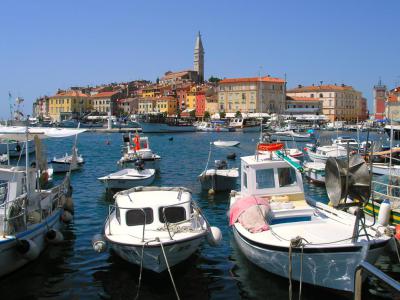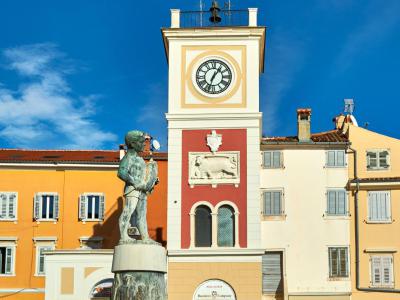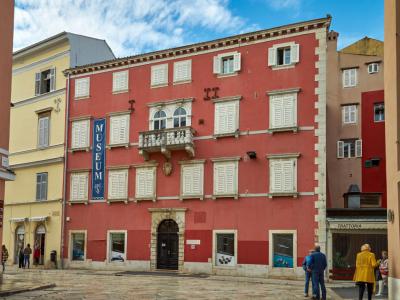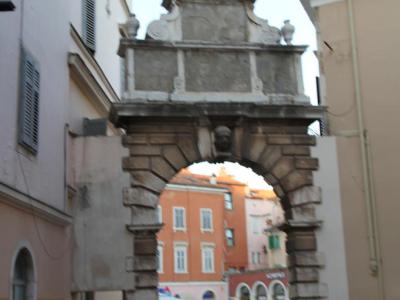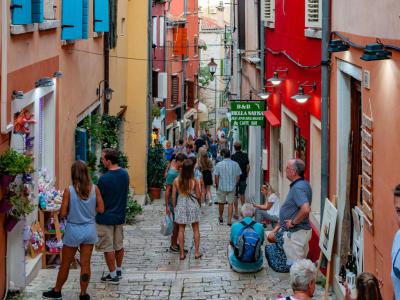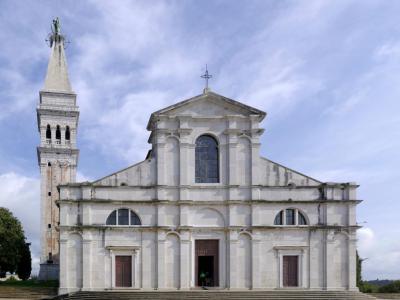Rovinj Introduction Walking Tour (Self Guided), Rovinj
The Croatian version of Saint Tropez before all the glitz and glamour, Rovinj is one of the most popular places in Croatia. Small, charming, laid back, and artistic, it's an excellent destination for couples, foodies, camping enthusiasts, and artists.
Nestled on the Istrian Peninsula's western coast, Rovinj is known for its dual identity as a tourist resort and a bustling fishing port. Officially bilingual in Croatian and Italian, it bears two names – Rovinj and Rovigno – both of which are official.
The name Rovinj is believed to have originated from the Etruscan word "Ruginium," which means 'hilltop' – and quite fittingly so, as the town indeed is perched atop a small hill. Originally built on an island, it was eventually connected to the mainland in 1763.
The town's history is intertwined with various civilizations, empires, and rulers, who left an indelible mark on its architecture and culture. In 1283, Rovinj became a significant part of the Republic of Venice, leading to the construction of defensive walls and town gates. Balbi's Arch and a Renaissance Clock Tower still stand as testaments to this era.
After passing through the hands of the Austrian Empire, the Kingdom of Italy, and Yugoslavia, Rovinj saw demographic shifts. In recent times, it has become a thriving center in Croatia's Istria County.
As you begin your exploration, a visit to the Port of Rovinj is a must. This historic harbor has been a hub of maritime activity for centuries, and today it offers a picturesque setting for leisurely strolls and enjoying fresh seafood at the local restaurants.
For a deeper dive into local history and culture, head to the Rovinj Heritage Museum. It houses a collection of artifacts and exhibits that trace the town's evolution through the ages.
Grisia Street is another gem of Rovinj, famous for its vibrant art scene.
And, of course, no visit to Rovinj is complete without a trip to the Church of Saint Euphemia and the Bell Tower. This stunning Baroque sanctuary dominates the skyline and offers panoramic views from its belfry.
Rovinj invites you to walk its cobbled streets, get lost within its old town, have a glass of wine by the sea, watch the world go by, and generally feel good. So, why wait? Embark on this self-guided journey now and let this hidden gem on the Adriatic coast leave an indelible mark in your heart!
Nestled on the Istrian Peninsula's western coast, Rovinj is known for its dual identity as a tourist resort and a bustling fishing port. Officially bilingual in Croatian and Italian, it bears two names – Rovinj and Rovigno – both of which are official.
The name Rovinj is believed to have originated from the Etruscan word "Ruginium," which means 'hilltop' – and quite fittingly so, as the town indeed is perched atop a small hill. Originally built on an island, it was eventually connected to the mainland in 1763.
The town's history is intertwined with various civilizations, empires, and rulers, who left an indelible mark on its architecture and culture. In 1283, Rovinj became a significant part of the Republic of Venice, leading to the construction of defensive walls and town gates. Balbi's Arch and a Renaissance Clock Tower still stand as testaments to this era.
After passing through the hands of the Austrian Empire, the Kingdom of Italy, and Yugoslavia, Rovinj saw demographic shifts. In recent times, it has become a thriving center in Croatia's Istria County.
As you begin your exploration, a visit to the Port of Rovinj is a must. This historic harbor has been a hub of maritime activity for centuries, and today it offers a picturesque setting for leisurely strolls and enjoying fresh seafood at the local restaurants.
For a deeper dive into local history and culture, head to the Rovinj Heritage Museum. It houses a collection of artifacts and exhibits that trace the town's evolution through the ages.
Grisia Street is another gem of Rovinj, famous for its vibrant art scene.
And, of course, no visit to Rovinj is complete without a trip to the Church of Saint Euphemia and the Bell Tower. This stunning Baroque sanctuary dominates the skyline and offers panoramic views from its belfry.
Rovinj invites you to walk its cobbled streets, get lost within its old town, have a glass of wine by the sea, watch the world go by, and generally feel good. So, why wait? Embark on this self-guided journey now and let this hidden gem on the Adriatic coast leave an indelible mark in your heart!
How it works: Download the app "GPSmyCity: Walks in 1K+ Cities" from Apple App Store or Google Play Store to your mobile phone or tablet. The app turns your mobile device into a personal tour guide and its built-in GPS navigation functions guide you from one tour stop to next. The app works offline, so no data plan is needed when traveling abroad.
Rovinj Introduction Walking Tour Map
Guide Name: Rovinj Introduction Walking Tour
Guide Location: Croatia » Rovinj (See other walking tours in Rovinj)
Guide Type: Self-guided Walking Tour (Sightseeing)
# of Attractions: 7
Tour Duration: 1 Hour(s)
Travel Distance: 0.6 Km or 0.4 Miles
Author: DanaOffice
Sight(s) Featured in This Guide:
Guide Location: Croatia » Rovinj (See other walking tours in Rovinj)
Guide Type: Self-guided Walking Tour (Sightseeing)
# of Attractions: 7
Tour Duration: 1 Hour(s)
Travel Distance: 0.6 Km or 0.4 Miles
Author: DanaOffice
Sight(s) Featured in This Guide:
- Port of Rovinj
- Marsala Tita Square
- Clock Tower
- Rovinj Heritage Museum
- Balbi's Arch
- Grisia Street
- Church of St. Euphemia and the Bell Tower
1) Port of Rovinj (must see)
Nestled on the northern Adriatic coastline, the Port of Rovinj, stands as a picturesque port town that beckons visitors with its irresistible charm and vibrant atmosphere.
The heart and soul of Rovinj lies in its port, which has remained a bustling hub of activity for centuries. What sets this port apart is that it stands as one of the last bastions in the Mediterranean Sea where fishing is not just a trade but a way of life. Early in the morning, before the sun graces the horizon, the local fishermen set out to sea on their small boats. They embark on a timeless ritual, returning to the harbor with the day's bounty of the freshest catch. This seafood, brimming with flavor, finds its way to the kitchens of homes and restaurants, ensuring that every meal in Rovinj is a feast of the sea.
As you meander along the quayside, you'll be greeted by the sight of an array of boats. The juxtaposition of traditional fishing vessels with swanky yachts creates a dynamic visual that mirrors Rovinj's evolution from a humble fishing village to a renowned travel destination.
The harbor area itself is a treat for the senses, boasting a wide array of boats, from small fishing crafts to luxurious yachts. The cobblestone streets that snake around the port are adorned with inviting pavement cafes, providing the perfect setting for sipping a refreshing drink and watching the world go by. What's more, the harbor offers numerous benches for those who prefer to relax without partaking in a meal or drink. It's a place where you can savor the beauty of Rovinj without any obligations.
This beautiful old port is teeming with history and character, inviting exploration at every corner. The town's warm Mediterranean ambiance is on full display, with an abundance of restaurants, bars, and tavernas lining the harbor and tucked away in the charming cobbled backstreets. Here, you can delight in sumptuous cuisine while soaking in the captivating views of the harbor. Whether you're drawn to the waterfront or prefer the cozy atmosphere of the town's historic streets, the Port of Rovinj provides a delightful backdrop to your Croatian adventure.
The heart and soul of Rovinj lies in its port, which has remained a bustling hub of activity for centuries. What sets this port apart is that it stands as one of the last bastions in the Mediterranean Sea where fishing is not just a trade but a way of life. Early in the morning, before the sun graces the horizon, the local fishermen set out to sea on their small boats. They embark on a timeless ritual, returning to the harbor with the day's bounty of the freshest catch. This seafood, brimming with flavor, finds its way to the kitchens of homes and restaurants, ensuring that every meal in Rovinj is a feast of the sea.
As you meander along the quayside, you'll be greeted by the sight of an array of boats. The juxtaposition of traditional fishing vessels with swanky yachts creates a dynamic visual that mirrors Rovinj's evolution from a humble fishing village to a renowned travel destination.
The harbor area itself is a treat for the senses, boasting a wide array of boats, from small fishing crafts to luxurious yachts. The cobblestone streets that snake around the port are adorned with inviting pavement cafes, providing the perfect setting for sipping a refreshing drink and watching the world go by. What's more, the harbor offers numerous benches for those who prefer to relax without partaking in a meal or drink. It's a place where you can savor the beauty of Rovinj without any obligations.
This beautiful old port is teeming with history and character, inviting exploration at every corner. The town's warm Mediterranean ambiance is on full display, with an abundance of restaurants, bars, and tavernas lining the harbor and tucked away in the charming cobbled backstreets. Here, you can delight in sumptuous cuisine while soaking in the captivating views of the harbor. Whether you're drawn to the waterfront or prefer the cozy atmosphere of the town's historic streets, the Port of Rovinj provides a delightful backdrop to your Croatian adventure.
2) Marsala Tita Square
Marsala Tita Square stands as a central focal point in Rovinj, offering a delightful space for relaxation and people-watching. The square invites you to savor coffee on café terraces, admire the central fountain, and soak in the surrounding historical architecture.
This public square was named in honor of the former Yugoslavian dictator, Josip Broz Tito, who held power from 1944 to 1980. While journeying through Croatia, you may come across other squares with the same name, such as the ones in Zagreb and Matulji.
As you wander towards the square's heart, you'll encounter a charming fountain. This centerpiece features a sculpture of a young boy holding a fish, with smaller fish below, gracefully spouting water from their mouths.
Take a moment to appreciate the reddish façade of the Rovinj Heritage Museum, which flanks the square. This magnificent 17th-century building was a Baroque palace belonging to the Califfi counts. Today, it houses a captivating collection of Croatian art and various archaeological artifacts.
To the north of the square stands Balbi’s Arch. This Baroque gateway serves as the entrance to the old Venetian town of Rovinj. Be sure to observe the intricate carvings of the Balbi family coat of arms and the winged Lion of St. Mark, an emblem of Venice, located above the arch. At the square's northern end, you'll find the path leading to Tri Valdibora, a small produce market where you can purchase fresh fruits and vegetables from the market stalls.
The square opens up to the harbor, providing picturesque vistas of the Sveta Katarina and Crevni Otok islands. With a constant flow of boats and people bustling about, it's an ideal spot to sit back, unwind, and people-watch. Enjoy a refreshing drink or indulge in some ice cream at the open-air terraces while the square's lively ambiance unfolds with an array of individuals passing by.
This public square was named in honor of the former Yugoslavian dictator, Josip Broz Tito, who held power from 1944 to 1980. While journeying through Croatia, you may come across other squares with the same name, such as the ones in Zagreb and Matulji.
As you wander towards the square's heart, you'll encounter a charming fountain. This centerpiece features a sculpture of a young boy holding a fish, with smaller fish below, gracefully spouting water from their mouths.
Take a moment to appreciate the reddish façade of the Rovinj Heritage Museum, which flanks the square. This magnificent 17th-century building was a Baroque palace belonging to the Califfi counts. Today, it houses a captivating collection of Croatian art and various archaeological artifacts.
To the north of the square stands Balbi’s Arch. This Baroque gateway serves as the entrance to the old Venetian town of Rovinj. Be sure to observe the intricate carvings of the Balbi family coat of arms and the winged Lion of St. Mark, an emblem of Venice, located above the arch. At the square's northern end, you'll find the path leading to Tri Valdibora, a small produce market where you can purchase fresh fruits and vegetables from the market stalls.
The square opens up to the harbor, providing picturesque vistas of the Sveta Katarina and Crevni Otok islands. With a constant flow of boats and people bustling about, it's an ideal spot to sit back, unwind, and people-watch. Enjoy a refreshing drink or indulge in some ice cream at the open-air terraces while the square's lively ambiance unfolds with an array of individuals passing by.
3) Clock Tower
The Clock Tower in Rovinj stands proudly on Marshal Tito Square, serving as a remarkable historical landmark. This tower, originally built in the 12th century, was positioned on the southern corner of the former city walls of Rovinj.
Throughout its long history, the Rovinj Clock Tower underwent various upgrades, and it now features a clock from the 14th century, housed within the striking red tower. This clock tower, rising as the tallest structure on the square, prominently displays the Lion of Saint Mark, a powerful symbol representing the Venetian Republic. It's impossible to overlook this iconic emblem.
Standing as one of the highest points in Rovinj, rivaling only the Church of St. Euphemia, the Rovinj Clock Tower is a fantastic spot for taking selfies and serves as a distinctive symbol of the town. In addition to its time-telling role, the tower has a storied history, as it was extended multiple times and even featured a prison for minor offenders beneath its stony foundations.
The town clock, adorned with the Venetian lion, a symbol of the Serenissima dating back to the mid-19th century, was originally situated on the town gate fort near the Califfi Palace.
Throughout its long history, the Rovinj Clock Tower underwent various upgrades, and it now features a clock from the 14th century, housed within the striking red tower. This clock tower, rising as the tallest structure on the square, prominently displays the Lion of Saint Mark, a powerful symbol representing the Venetian Republic. It's impossible to overlook this iconic emblem.
Standing as one of the highest points in Rovinj, rivaling only the Church of St. Euphemia, the Rovinj Clock Tower is a fantastic spot for taking selfies and serves as a distinctive symbol of the town. In addition to its time-telling role, the tower has a storied history, as it was extended multiple times and even featured a prison for minor offenders beneath its stony foundations.
The town clock, adorned with the Venetian lion, a symbol of the Serenissima dating back to the mid-19th century, was originally situated on the town gate fort near the Califfi Palace.
4) Rovinj Heritage Museum
The Rovinj Heritage Museum has a rich and artistic history. Established in 1954 by a group of local Rovinj artists, the museum was envisioned not only as a place for preserving cultural wealth but also as a venue for showcasing the works of artists.
Since its inception in 1954, the Rovinj Heritage Museum has diligently curated a valuable collection that spans various realms of art and culture. This includes a diverse assortment of modern artworks, as well as pieces from old masters of art. The museum also boasts a significant collection of archaeological artifacts, ethnological items, historical books, documents, and a fascinating compilation of photographs related to the partisan battalion led by Pino Budicin.
The Rovinj Heritage Museum, however, faces constraints due to limited space, which prevent it from displaying its extensive collection in its entirety. Nonetheless, the museum is a cultural gem, and the sections open to the public offer a rich glimpse into the town's heritage and artistic legacy.
This museum is housed within the elegant Baroque palace of the Counts Califfi, a structure that embodies the architectural charm of the 17th and 18th centuries. You can find the Rovinj Heritage Museum located at Square Marshal Tito, where visitors can immerse themselves in the vibrant cultural tapestry of this delightful coastal town.
Since its inception in 1954, the Rovinj Heritage Museum has diligently curated a valuable collection that spans various realms of art and culture. This includes a diverse assortment of modern artworks, as well as pieces from old masters of art. The museum also boasts a significant collection of archaeological artifacts, ethnological items, historical books, documents, and a fascinating compilation of photographs related to the partisan battalion led by Pino Budicin.
The Rovinj Heritage Museum, however, faces constraints due to limited space, which prevent it from displaying its extensive collection in its entirety. Nonetheless, the museum is a cultural gem, and the sections open to the public offer a rich glimpse into the town's heritage and artistic legacy.
This museum is housed within the elegant Baroque palace of the Counts Califfi, a structure that embodies the architectural charm of the 17th and 18th centuries. You can find the Rovinj Heritage Museum located at Square Marshal Tito, where visitors can immerse themselves in the vibrant cultural tapestry of this delightful coastal town.
5) Balbi's Arch
Balbi's Arch is an iconic historical landmark situated in Rovinj, constructed between 1678 and 1679. This impressive archway serves as the entrance to Grisia Street. It has captivating details, featuring the carved head of a Turk on one side and a Venetian head on the other. This arch now stands on the very spot that was once occupied by the old town gate.
Rovinj's history reveals that during the 7th century, the city was fortified and subsequently strengthened with additional defensive towers. At that time, there were seven city gates in total, but only three have survived to this day: "The gates under the wall," "The gates of St. Benedict," and "The gates of the Holy Cross."
Balbi's Arch stands on the exact location where the main entrance to the fortified city, Porton della Pescheria, once stood. This gate was demolished during the mayoralty of Daniel Balbi in the late 17th century. An inscription on a stone tablet still commemorates this historical event. Today, the Balbi's Arch serves as the principal gateway to Rovinj's Old Town and is recognizable by the presence of the welcoming Venetian lion and the Balbi family crest.
Rovinj's history reveals that during the 7th century, the city was fortified and subsequently strengthened with additional defensive towers. At that time, there were seven city gates in total, but only three have survived to this day: "The gates under the wall," "The gates of St. Benedict," and "The gates of the Holy Cross."
Balbi's Arch stands on the exact location where the main entrance to the fortified city, Porton della Pescheria, once stood. This gate was demolished during the mayoralty of Daniel Balbi in the late 17th century. An inscription on a stone tablet still commemorates this historical event. Today, the Balbi's Arch serves as the principal gateway to Rovinj's Old Town and is recognizable by the presence of the welcoming Venetian lion and the Balbi family crest.
6) Grisia Street
Grisia Street, locally referred to as Grizia, is a charming and narrow thoroughfare located in the heart of Rovinj's historic old town. Grisia is not only the most renowned but also the longest street in the Old Town center of Rovinj, characterized by its distinctive feature of numerous steps. This charming thoroughfare serves as a vital link, connecting the very base of the town to its picturesque summit. This quaint street winds its way towards the majestic Church of St. Euphemia, and it is renowned for hosting a captivating fine arts event that has become an annual tradition, attracting artists from all corners of Croatia and Europe.
What sets the Grisia Street event apart is its inclusivity, as it welcomes not only seasoned academic artists but also talented amateurs and even budding child artists. The artwork adorns the walls of Grisia Street, creating a striking open-air gallery that entices hundreds of visitors to wander through the cobbled streets like a bustling ant colony.
The tradition of this art exhibition on Grisia Street began in the summer of 1967 and has since been faithfully observed every year on the first Sunday in August. One of the most appealing aspects of this event is its accessibility; anyone who registers in the morning at the Rovinj Heritage Museum can participate as an exhibitor, making it an event of both artistic excellence and community spirit.
As you explore Grisia, you'll find not only captivating paintings but also an array of other artistic expressions, including handcrafted jewelry, ceramics, traditional Istrian souvenirs, live performances, and even sculptures by local artists. The abundance of galleries, studios, and art exhibitions that line Grisia has rightfully earned it the title of an "artist street."
What sets the Grisia Street event apart is its inclusivity, as it welcomes not only seasoned academic artists but also talented amateurs and even budding child artists. The artwork adorns the walls of Grisia Street, creating a striking open-air gallery that entices hundreds of visitors to wander through the cobbled streets like a bustling ant colony.
The tradition of this art exhibition on Grisia Street began in the summer of 1967 and has since been faithfully observed every year on the first Sunday in August. One of the most appealing aspects of this event is its accessibility; anyone who registers in the morning at the Rovinj Heritage Museum can participate as an exhibitor, making it an event of both artistic excellence and community spirit.
As you explore Grisia, you'll find not only captivating paintings but also an array of other artistic expressions, including handcrafted jewelry, ceramics, traditional Istrian souvenirs, live performances, and even sculptures by local artists. The abundance of galleries, studios, and art exhibitions that line Grisia has rightfully earned it the title of an "artist street."
7) Church of St. Euphemia and the Bell Tower (must see)
The Church of Saint Euphemia, often referred to as the Basilica of Saint Euphemia is a magnificent Baroque church nestled in the heart of Rovinj's historic district. Its construction, dating from 1725 to 1736, stands atop the remnants of earlier, early Christian structures. Originally dedicated to Saint George and later to Saints George and Euphemia, the present church is solely devoted to Saint Euphemia. Its splendid façade, as we see it today, was added in 1883.
Inside, the church safeguards the relics of Saint Euphemia in a Roman sarcophagus dating back to the sixth century, later adapted in the 15th century. The church houses an array of treasures and artistic works, including Gothic statues from the 15th century and paintings from the 16th and 17th centuries, such as the Last Supper and Christ in the Gethsemane.
One of the most striking features of the church is its bell tower, which bears a resemblance to the iconic tower of Saint Mark's Basilica in Venice. This impressive structure was built between 1654 and 1680, based on the designs by Antonio Manopola. Crowning this 60-meter-high tower is a statue of Saint Euphemia, serving as a weathervane. The legend associated with the church describes how the sarcophagus bearing her remains was received. It recounts the tale of two fishermen caught in a fierce storm who, through their earnest prayers, miraculously find themselves near Rovinj's shore, witnessing a radiant white light over an object that sinks into the sea. With the town's inhabitants unable to move the heavy object, a pious widow devises a plan to retrieve the gift using oxen. Miraculously, the oxen successfully haul the sarcophagus from the water and up the hill.
The legend is further enriched by an incident where a skeptic is struck unconscious in the presence of the sarcophagus, later revealing that he had received a vision from Saint Euphemia herself, confirming that the sarcophagus contained her sacred remains. According to local folklore, this hill has been known as the "Hill of Saint Euphemia" ever since these events, even as the relics faced tumultuous circumstances, including theft by the Genoese and eventual return to the town in the 14th century. The Church of Saint Euphemia, with its rich history and legendary tales, stands as a testament to the enduring spirit of faith and devotion in Rovinj.
Inside, the church safeguards the relics of Saint Euphemia in a Roman sarcophagus dating back to the sixth century, later adapted in the 15th century. The church houses an array of treasures and artistic works, including Gothic statues from the 15th century and paintings from the 16th and 17th centuries, such as the Last Supper and Christ in the Gethsemane.
One of the most striking features of the church is its bell tower, which bears a resemblance to the iconic tower of Saint Mark's Basilica in Venice. This impressive structure was built between 1654 and 1680, based on the designs by Antonio Manopola. Crowning this 60-meter-high tower is a statue of Saint Euphemia, serving as a weathervane. The legend associated with the church describes how the sarcophagus bearing her remains was received. It recounts the tale of two fishermen caught in a fierce storm who, through their earnest prayers, miraculously find themselves near Rovinj's shore, witnessing a radiant white light over an object that sinks into the sea. With the town's inhabitants unable to move the heavy object, a pious widow devises a plan to retrieve the gift using oxen. Miraculously, the oxen successfully haul the sarcophagus from the water and up the hill.
The legend is further enriched by an incident where a skeptic is struck unconscious in the presence of the sarcophagus, later revealing that he had received a vision from Saint Euphemia herself, confirming that the sarcophagus contained her sacred remains. According to local folklore, this hill has been known as the "Hill of Saint Euphemia" ever since these events, even as the relics faced tumultuous circumstances, including theft by the Genoese and eventual return to the town in the 14th century. The Church of Saint Euphemia, with its rich history and legendary tales, stands as a testament to the enduring spirit of faith and devotion in Rovinj.
The Most Popular Cities
/ view all



